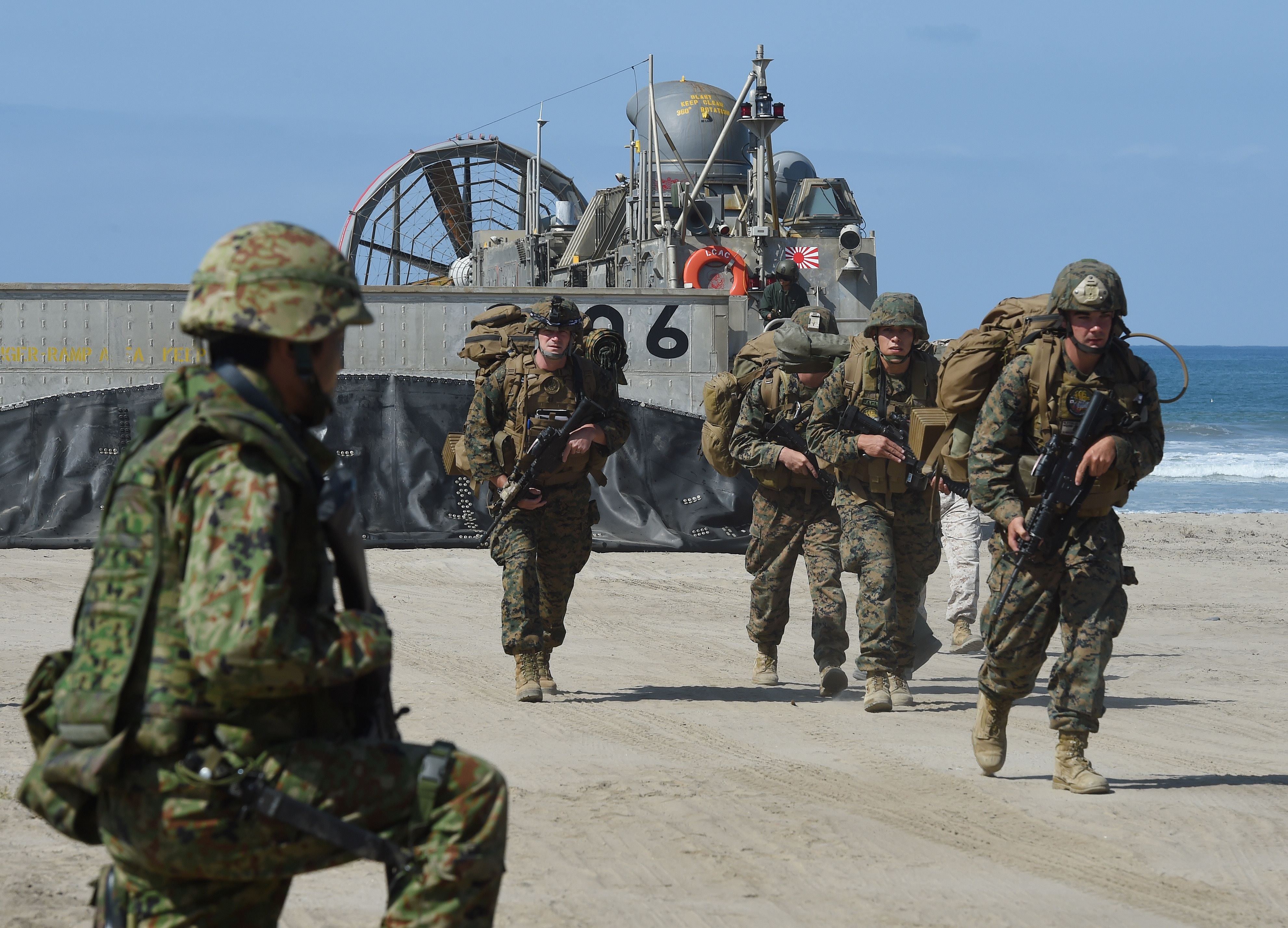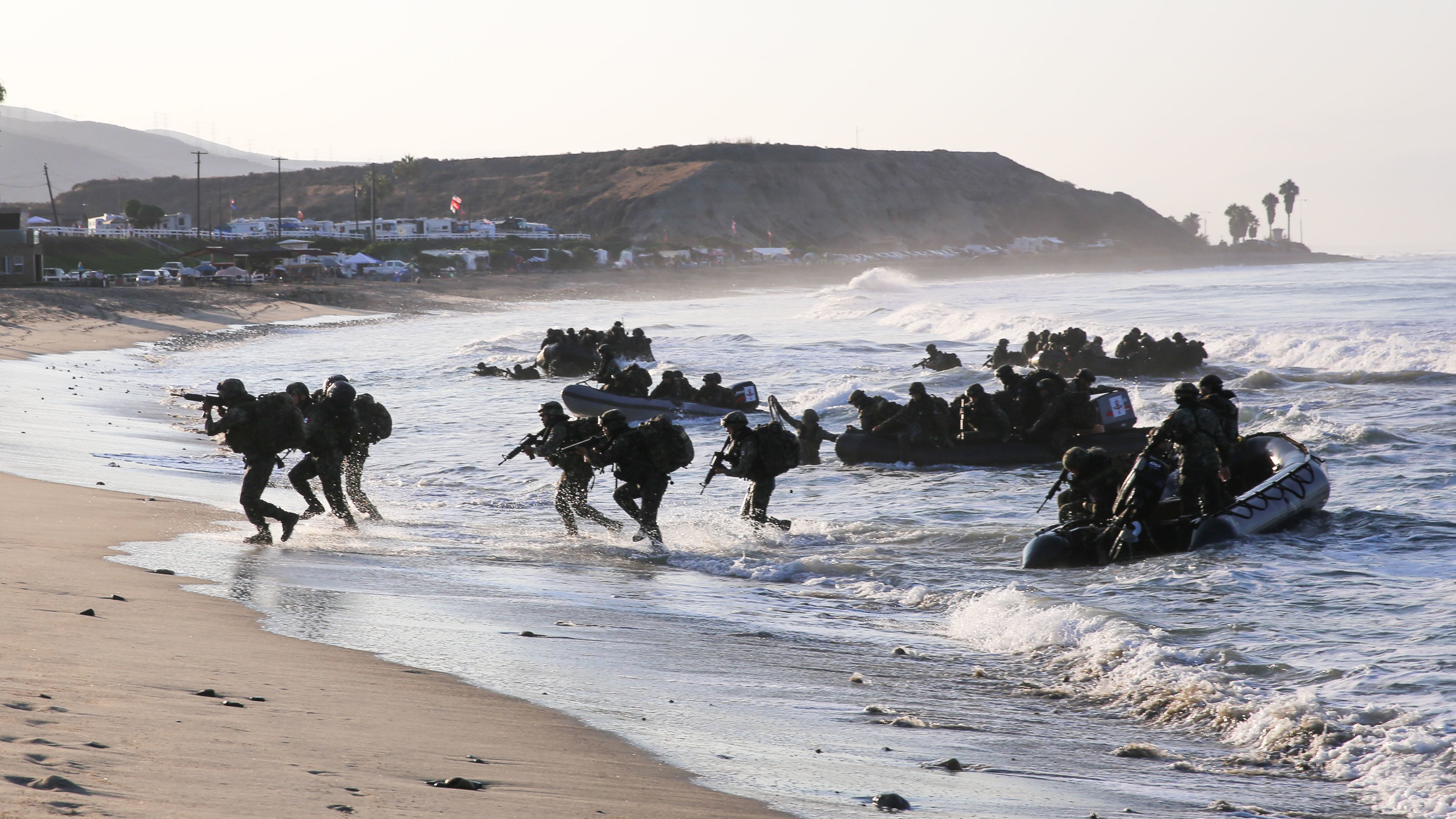CAMP PENDLETON, Calif. — The troops soldiers coming ashore during Dawn Blitz for amphibious training exercise "Dawn Blitz" this month displayed national flags on their sleeves not often seen along the Camp Pendleton's beaches here.
The coalition landing force participating in hitting the beach during the multinational amphibious training exercise represented several key U.S. allies in the Pacific: Mexico, Japan and New Zealand. Each country's military is bolstering its military and amphibious capabilities and tactics, and their . Their participation in the Navy-Marine Corps and Navy's brigade-level exercise helped them hone their skills develop their own from-the-sea capabilities, and in a multinational environment.
It was the first time Mexican marines participated , in its first participation in Dawn Blitz, which ran through Sept. 10. The Mexican navy sent a tank landing ship, a patrol ship, several Usumacinta, patrol ship Revolucion and patrol boats, two helicopters and a 134-man naval infantry company of Mexican Marines.
Japan, which is in the midst of modernizing its naval forces to defend the remote islands, sent three ships, helicopters, an air-cushioned landing craft and members of the Maritime Self-Defense Force. ships – helicopter destroyer Hyuga, tank landing ship Kunisaki[cqgf] and guided missile destroyer Ashigara[cqgf] — for the exercise, plus MH-47 Chinook and AH-6 Apache helicopters and air-cushioned landing craft along with Japan Ground Self Defense Force troops.
The Kiwis sentd 102 members of soldier Victor Company, 1st Battalion, with the Royal New Zealand Infantry Regiment. [cqgf], and lLogistics troops also flew to California and joined Marines on Navy ships. They went ashore for amphibious, urban, weapons and live-fire training here at Camp Pendleton and on San Clemente Island.
The troops multinational force formed "Amphibious Force 3," led by 1st Marine Expeditionary Brigade and San Diego-based Expeditionary Strike Group 3. Amphibious assault ship Boxer was the flagship for the task force that included seven U.S. Navy ships and observers from Colombia, Chile and Australia.
"We are going to fight as a coalition," Brig. Gen. David Coffman[cqgf], the 1st MEB commander, said during the exercise, that the force was going to practice fighting as a coalition Sept. 6.
"This particular grouping is a really interesting one," said Coffman, who recently led U.S. Marine Corps Forces South commander for two years. "There are some political relationships, or [rules that set] sets, the way you do coalition work. To be able to respect that and still employ them effectively, that's a real challenge with a diverse... kind of group of partners and allies."
Officials say coalition amphibious training requires much deliberate planning – and patience – adjusting as the training scenarios progress. Many moving parts, from launching landing craft to navigating breaking waves and clearing airspace, makes timing critical. "It's as complex and as difficult as anything we do," said Coffman.
A first for Mexican marines
Mexico practiced landing naval infantrymen forces ashore in Zodiac Zodiak boats or patrol boats from their ships. The force is improving military tactics and refining capabilities for amphibious operations and as well as disaster relief missions.
"At the tactical level, we are ready to be able to come and continue participating," said Mexcian navy Capt. Gabriel Gutierrez de Velasco Alvarez, the Mexican amphibious task force commander.
The coalition force organized into two elements: Marines paired with New Zealand and Mexico while Japan led its blue-green force, an arrangement driven by treaty. "We've had very interesting national caveats and ways to work our way through that," Coffman said, "so they have operated as an adjacent force."
"[Mexico] has really stepped up to be a great part of our coalition," Coffman said. "I understand where Mexico is trying to go with its capability, and we look forward to doing more work with them. They are great partners."
The presence of Mexican marines was notable. Some are with a battalion based in Vera Cruz, a Gulf port and hotbed of turf battles between and war with drug cartels. The marines also provide the where Marines also provide the local police protection there.
"For our Mexican friends, we are especially proud of their courage to come in and jump right into this," Coffman said.
While communication was sometimes a challenge during the exercise, the Mexican marines were committed to throwing their all into the exercise in order to meet their objectives, said Mexican navy Capt. Gabriel Gutierrez de Velasco Alvarez, the Mexican amphibious task force commanderGutierrez de Velasco said during a Sept. 6 press conference aboard the Mexican tank landing ship Usumacinta.
"This is an opportunity for the Mexican forces to interact with equivalent forces," he said "In this type of military operations, there is no room for errors. There is no room for mistakes. ...We are working together. We are also working with the guidance of the U.S. forces in learning how we can better interact with those different forces."
That's helping them even as they"struggled a little bit to understand and to bring the plans into action once we start working (with) the Marines and the Navy," he said. While communication was a challenge, "we are working on that very hard. In this type of military operations, there is no room for errors. There is no room for mistakes. So the orders have to be transferred and accepted quickly, and we have to understand clearly what is the goal. "
A strong Bolder Japanese presence
As Japan continues to grapple with disputes with China over overt Chinese activity in the South China Sea and claims to islands in the South China Sea, Lt. Gen. Koji Yamazaki, Japan's vice chief of staff, said the training during Dawn Blitz helps his force prepare for a possible attack. Japan's Senkaku Islands, or what China calls Daioyu.
"In the future, we are to make effort to strengthen the Japan-U.S. alliance," he said in a Sept. 5 press conference at Red Beach. "...[Dawn Blitz] has significant meaning to strengthen the Japan-U.S. alliance as well as improve and maintain amphibious capabilities required to respond to an attack on the remote islands of Japan."

A Japanese soldier, left, keeps watch as Japanese troops disembark from their landing craft air-cushion hovercraft during Exercise Dawn Blitz in California. The exercise wrapped up on Sept. 10.
Photo Credit: Mark Ralston/Getty Images
Japan is three years into an effort to grow its amphibious capability. "This was the first time a U.S. amphibious unit and a JSDF amphibious units has trained together.
"This is significant," said Grant Newsham[cqgf], a retired Marine and senior research fellow with the Japan Forum for Strategic Studies who observed the exercise.
The Marine Corps and Navy "made an effort to really participate... and most importantly to fully draw in the Japanese as operating partners," Newsham said. While the exercise was probably the best exercise between by the Marine Corps and Japan, he said, the "important thing is what comes next."
An improved Japan amphibious force could serve as a de facto Marine expeditionary unit EU, perhaps in northeast Asia, Newsham said.
and help "a more solid and useful U.S.-Japan defense relationship," he said. "The test now is whether we can keep the amphib development effort going," he said. Amphib capability has no natural constituency in most militaries, including JSDF. Thus, must keep the momentum going."
Hitting the beach
At Camp Pendleton's Green Beach, a sandy stretch at San Onofre Beach and campground, a company of Mexican marines zipped toward the sandy shoreline in nine black rubber Zodiak boats. They launched from a Mexican tank landing ship Usumacinta and sped through light swells not far from moving toward "Church" shore break where more than about 50 surfers bobbing ed in the water at San Onofre Beach.
Marines marked the landing zone along a rock-strewn stretch, but the Mexicans landed further south, zipping onto the sand and scrambling with rifles pointed toward the high tide line. Dozens of campers, surfers and holiday beach-goers watched the morning mock assault. Kiwi troops bobbed in Marine Corps amtracs that disembarked New Orleans a few miles away, and soon eight amphibious assault vehicles AAVs came ashore, some near wayward surfers.

Mexican marines storm the shoreline at Camp Pendleton, Calif., during Exercise Dawn Blitz. It was the first time Mexican marines participated in the amphibious exercise.
Photo Credit: Pfc. Devan Gowans/Marine Corps
As New Zealand is working on works on is developing a tri-service amphibious task force capability, key to its 2035 strategic plan, Kiwi Army Col. Hugh McAslan, an army brigade commander, said the training was good exposure for his soldiers. Dawn Blitz "is all about building our capabilities for amphibious operations and, importantly, working along our American partners. In our part of the world here in the Pacific, you can find yourself operating at any time alongside (partners), particularly in disaster relief."
The training "is really good exposure for our guys at this level," said McAslan, who commands 1st Brigade in Linton Camp. "New Zealand is a small country, so we don't have a lot of the assets that you are exposed to here," he said.
Dawn Blitz helps build important partnerships, McAslan added, that are vital in his region.
"In our part of the world here in the Pacific, you can find yourself operating at any time alongside [partners], particularly in disaster relief," he said.
They don't have amphibious vehicles like AAVs, so "this is a pretty new experience for them." They don't have dedicated training beaches, either.
They're learning how to establish baseline training in planning, command and control, procedures and common language critical for amphibious ops, McAslan said. "It is a complex operation. It's how you integrate all those different functions of the the Navy and, in our case, the Army, and your rear components."
The Marines' expert input in amphib operations continues this fall when Marines join them for a large amphibious exercise in New Zealand, he said. "For us, it's about taking a very deliberate and progressive approach. You've got to develop capabilities and also suit it to what your nation's most likely to utilize it for."





